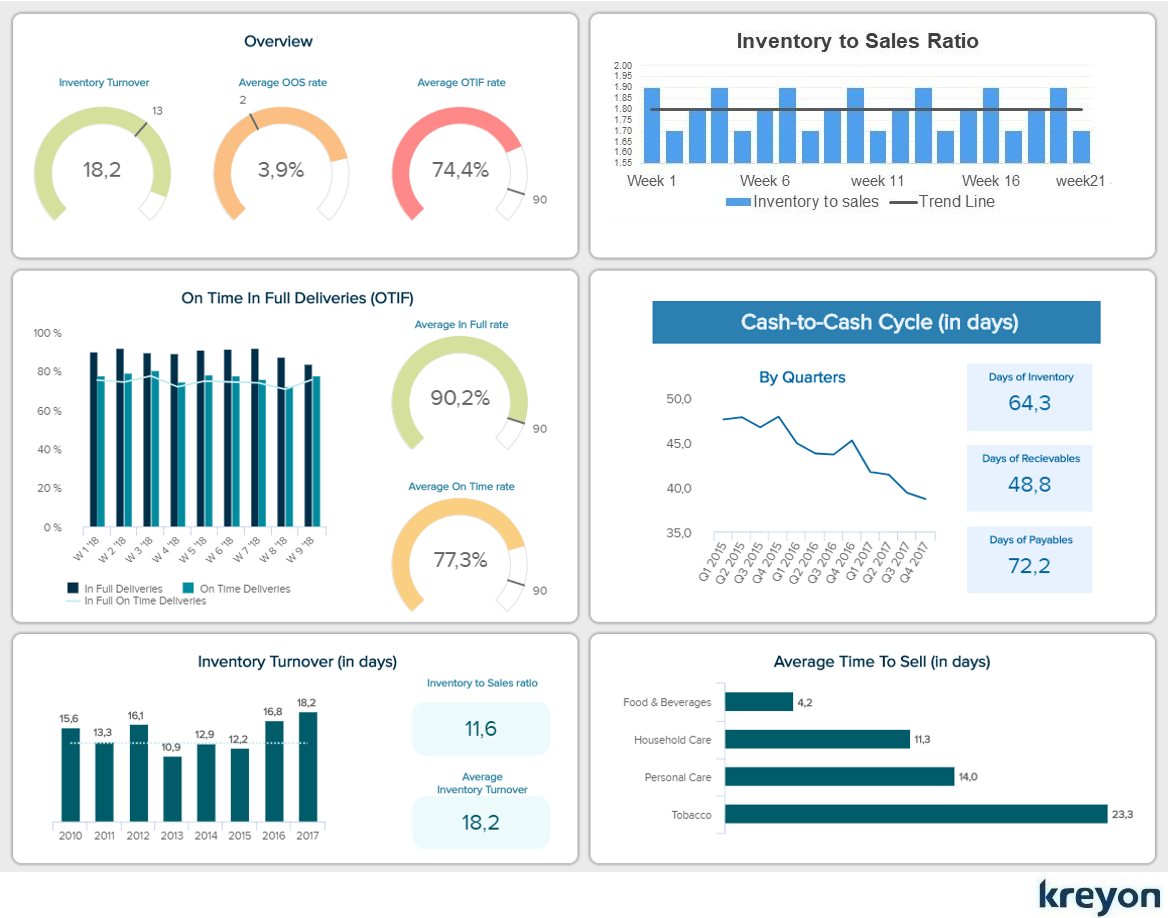Supply Chain Management KPI for Improving Business Performance

Supply Chain Management KPI (key performance indicators) can help an organisation to visualise the data at every step of the business cycle. A dynamic and flexible supply chain gives robust control of the business. When the supply chain visibility is high, companies can work on removing the bottlenecks early to deliver top performing products and services driven by data.
Supply chain management KPI help a company to measure, track and report key numbers of the business. It leads to gamification of the steps involved in building and delivering products and services to the customers. It leads to adoption of the best practices, analysis of the business processes and reducing the lags to achieve superior outcomes for an organisation. Here’s a look at the SCM KPI for improving the business performance:
1. On Time in Full On Request (OTIFR)
The OTIFR represents the percentage of orders fulfilled on customer’s request date. The OTIFR measures the orders completed on or before the date mandated by the customer. This metric can be used to measure the efficiency of the
supply chain.
The OTIFR is measured as:
(Total No. of Orders competed On Time)
————————————————————– X 100
(Total No. of Orders Due for Delivery)
A high OTIFR percentage implies that orders are being shipped to the customers on time. As supply chain complexity rises with international vendors and suppliers, it can be a challenge to keep supply chain costs down and deliver on time. The delivery performance metric is one which customers rate very high on their list. OTIFR measures not only the orders delivered to the customers, but also their schedules.
2. Perfect Order Fulfillment
The perfect order fulfillment rate can be used to analyse the supply chain reliability and quality. It is measured as the no. of perfect orders delivered to the customers The perfect order fulfillment reduces the inventory requirements for an organisation, it reduces return rate and hence improved capital efficiency too. The reliability, consistency and performance of a company’s supply chain is depicted with a high perfect order fulfillment rate.
The perfect order fulfillment rate is calculated as follows:
(Total No. of Perfect Orders Delivered)
————————————————————– X 100
(Total No. of Orders Delivered)
The perfect order fulfillment varies according to demands. When the demand is high, organisations typically need to put in extra efforts to keep up with the perfect orders fulfilled. Companies with matured systems can predict demand and meet the needs of the customers with agility in a reliable manner.
3. Inventory Turnover ratio

One of the most critical needs for an organisation is to keep its supply chain costs optimised. It has an impact on its bottomline. The supply chain costs could be broken down into warehousing, inventory carrying costs, customer service, transport, and logistics etc.
The supply chain performance can be analysed using metrics like:
The total net sales for an organisation in a given time period is used for calculating the inventory turnover ratio. In any given period the ratio of net sales to average inventory value needs to be optimised. When net sales are high and optimised, it reduces the inventory carrying costs, and also meets the sales needs of the company.
Inventory turnover ratio is calculated as:
(Net Sales)
—————————————-
(Average Inventory Value)
where average inventory = (beginning inventory + ending inventory) / 2
The total supply chain costs include warehousing, inventory carrying costs, transportation, damaged/returned items, customer support, compliance costs and other extra ordinary items. Typically, high inventory turnover denotes fast moving items. Apple Inc has an inventory turnover ratio of 8.67 for the 3 month period ending in June 2022. An inventory turnover ratio of 5-10 is considered good.
4. Average Cash-to-Cash Cycle
The cash flow is the backbone of any organisations, companies that operate with good net profits and cash flow rule the roost. The cash to cash cycle is the average time period required to convert resources into cash, right from the time you purchase the inventory till you receive money for the sale of your products/inventory. In short, the cash to cash cycle time represents the cash collection time for your products or services.
The cash to cash cycle should be as small as possible, a larger time window represents poor cash flow for a business. The three financial metrics used for measuring cash to cash cycle are days of inventory (DOI), days of payables (DOP) and days sales outstanding (DSO).
The cash to cash cycle time is computed as follows:
(Days of Inventory + Days Sales Outstanding) – (Days of Payables)
The smaller cash cycle time is ideal for a business. Companies like Apple typically maintain negative cash to cash cycle, infact, Apple had an average of -70 days cash to cash cycle for a period of 4 years.
Companies with negative cash to cash cycle typically collect payments for their goods in advance and even before they paid for their inventory. It also shows high market demand for a company’s products. Cash to cash cycle time is an important supply chain management KPI to evaluate cash position and market demand for a company’s products.
5. Customer Order Cycle Time
The customer order cycle time is the average time (in days) from order date to the actual delivery date of your product. Typically, companies optimise their supply chain operations to deliver their products at the earliest time with good quality checks.
The cash to cash cycle and customer order cycle time have an impact on the cash flow of an organisation. If the cash to cash cycle time is increasing, it could be due to increasing customer order cycle time. Often times, high customer order cycle time and high cash to cash cycle time could lead to poor cash flows for an organisation. The mismanagement of payables, receivables and poor inventory controls could lead to increasing customer order cycles.
With proactive supply chain automation, organisations can configure triggers and alerts at specified inventory levels. It could lead to procurement of inventory items and also alert management about any delays regarding the delivery of the products proactively.
6. Days on Hand

Inventory carrying costs impact the bottomline and profitability. But, the inventory availability is needed for delivering products to the customers. Days on hand is a metric that shows how quickly a company utilises the inventory items. It is defined in terms of the days inventory outstanding.
The days on hand metric can be calculated as:
(Average Inventory)
——————————————–
(Cost of sales)/(No. of days)
Say ABC Company owns an inventory of value $500,000 during the year 2022. The cost of sales for ABC corp is $100,000 for the same year.
Days on hand = $500,000
———— = 5X365 = 1825 days of inventory for 2022.
$100,000/365
Companies are using automation and supply chain software for predicting customer demands to lower their inventory days. By lowering inventory costs, businesses can improvise their capital spending as well as supply chain costs leading to an improved bottom line.
7. Forecast Error
Forecasting the demand for your products is an essential step in building a good supply chain. Many companies either underestimate or overestimate demand for their products leading to supply chain issues. The best companies use accurate demand forecasting models for coming up with fairly accurate predictions for their business.
The forecast error is calculated as:
(Actual Demand – Demand Forecast)
——————————————————— X 100
(Actual Demand)
The lower the forecasting error, the better the supply chain management for a company. When companies are able to forecast the demands for their products with high degree of accuracy, it can help them right size their inventory, save capital costs and deliver products on time as per customer demands.
8. Fill Rate
Fill rate refers to the customer orders that can be fulfilled by the company from its immediate inventory without backorders, stockouts and delays. Fill rate is a metric that can affect customer satisfaction. The percentage of orders successfully shipped to the customers based on their demand from the inventory available at the company.
The fill rate is expressed as:
(Total Orders Shipped)
————————————- X 100
(Total Orders Placed)
The fill rate is expressed as a percentage of orders successfully shipped in the first shipment to the customers. It leads to higher inventory turnover and reduces customer order lifecycle time. When organisations have a high fill rate, they have happier customers. The delays in shipping products to customers often lead to an increasing no.of cancelled orders. Supply chain automation can help companies improve their fill rates without excessive inventory by right demand predictions.
9. Supplier Performance Score

Supplier standards need to be assessed for creating a smooth supply chain management system. As a company, you need to procure raw materials from your most reliable suppliers and vendors.
Companies need to evaluate their vendors and measure their performance against factors like speed, quality, regulatory compliance, return orders, geographical location, costs and discounts etc.
Companies with strong supply chain capabilities negotiate favourable terms and conditions to maintain high fill rate, cash flows and optimum product quality. Supplier scorecards and metrics can help companies figure out their best suppliers and establish long term relationships with them. Companies need to provide their product requirements to the vendors and conduct their due diligence.
The suppliers could be evaluated based on metrics like average unit cost per item Vs market rate, average time to deliver orders, return rate, payment terms, capacity, risks etc. A good vendor score can be chosen for finalising the procurement of inventory items.
10. Gross Margin ROI
Gross margin ROI is a supply chain management KPI that is used to calculate the the profitability of a company. It shows the ROI from the inventory investment. This metric becomes more pertinent in case of inflation and volatile prices, companies can use this as a measure to stay on top of the pricing for their products.
GM ROI = (Gross Profit)
———————————————————————
[(Opening Stock – Closing Stock)/2] * 100
Companies that operate profitably generally have GM ROI of 200% or more. Many companies procure items at their lowest costs and optimise their inventory costs. The inventory items are bought as per their pricing cycles and movements to improve the profitability of the operations using SCM software. The more expensive and slow moving items are purchased as per the sales demand forecasts etc.
There are other supply chain management KPI used for creating stronger, more efficient and economically sustainable organisations.Some other supply chain performance measures used by leading companies:
Freight Cost per Unit
Accident Reports
Warehouse Cost Performance
Inventory Accuracy
Capacity Utilisation
The leading companies in retail, technology, manufacturing and other industries have mastered their supply chains delivering the goods despite all odds. Business growth is fueled by a synchronised supply chain from start to finish.
Kreyon Systems provides Supply Chain Management Software with advanced Warehousing & Logistics capabilities to improve the bottomline for businesses. If you have any queries for us or need assistance, please get in touch.
